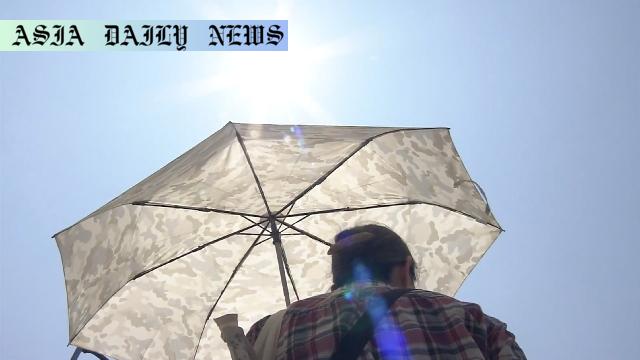Heatwave: Japan faces sweltering days with temperatures soaring up to 37°C, causing heatstroke concerns and continuing into Sunday.
Scorching heatwave grips Japan, breaking 35°C in many regions.
Heatstroke alerts issued for several prefectures as risks rise.
Temperatures are expected to remain high for the next month.
Authorities highlight importance of hydration and air conditioning.
Overnight temperatures may not drop below 25°C in some areas.

Heatwave Conditions Intensify Across Japan
In an alarming development, much of Japan has been engulfed in a brutal heatwave, with temperatures surging to 35 degrees Celsius or higher. This phenomenon has particularly affected western parts of the country, painting a dire picture of environmental and public health concerns. On Saturday, the town of Akiota in Hiroshima Prefecture recorded a blistering high of 36.4 degrees, while major cities like Tokyo and Osaka sweltered at 33.8 and 33.5 degrees, respectively. The ongoing heatwave is expected to continue, with Sunday bringing even higher temperatures to several regions.
Impact of Extreme Heat on Local Populations
The oppressive heat has already triggered significant health warnings, particularly concerning heatstroke. As of 3 p.m. on Saturday, the Tokyo Fire Department reported that 15 individuals—ranging in age from 18 to 99—had been hospitalized with symptoms linked to heatstroke. Residents, especially those in vulnerable age groups, are strongly advised to remain vigilant and prioritize their health by staying hydrated and avoiding prolonged exposure to the sun.
Regions like Kinki, Kyushu, Saga, and Fukuoka Prefecture are forecasted to experience temperatures as high as 37 degrees in the coming days. Additionally, overnight temperatures are expected to stay above the 25-degree mark, further exacerbating the discomfort and leaving little respite for a population already grappling with the heat.
Heatstroke Alerts and Safety Guidelines
In an effort to mitigate the risks posed by this heatwave, heatstroke alerts have been issued in multiple prefectures, including Shimane, Tokushima, Kochi, Fukuoka, and others across Okinawa’s main island and the Yaeyama regions. These alerts necessitate immediate action from residents, particularly those in high-risk zones, as they brace for continued heat. The Meteorological Agency has urged individuals to use air conditioners, stay hydrated with water and salt, and avoid prolonged outdoor activities where possible. These guidelines are essential for minimizing the health risks associated with heatstroke, exhaustion, and dehydration.
Prolonged Heatwave: A Broader Implication?
What makes this heatwave particularly concerning is the expectation of sustained high temperatures for the upcoming month. For regions that typically experience subtler summers, this shift may point to broader climatic changes influenced by global warming. Residents and local officials are now tasked with developing strategies to cope with what may no longer be a temporary anomaly but rather a sustained trend in the region’s weather patterns. Measures include increased public awareness through weather updates, better cooling infrastructure, and community-focused efforts to address vulnerable populations, including the elderly and outdoor workers.
How to Stay Safe Amidst the Heatwave
As these extreme conditions persist, adopting a proactive rather than reactive approach will be crucial. Simple practices like drinking plenty of fluids, avoiding sugary or alcoholic beverages, and wearing loose, light-colored clothing can make a significant difference. Those with access to cooling systems are encouraged to make full use of them and assist others who may not have such resources available.
Moreover, beyond individual measures, communities can play a role by opening public cooling centers and conducting welfare checks on at-risk individuals. The urgency of these steps cannot be overstated, especially when sweltering nights reduce the opportunity for physical recovery from the day’s heat exposure.
Conclusion
Japan finds itself confronted by an unrelenting heatwave, with temperatures reaching record highs and showing little sign of abating. As climate change becomes an everpressing concern, strategies for coping with and preventing the adverse effects of these conditions must evolve. Public awareness, government intervention, and individual preparedness will collectively determine how effectively the nation handles such extreme and potentially life-threatening circumstances.



Commentary
The Heatwave: A Test of Resilience
As Japan battles soaring temperatures brought on by an unrelenting heatwave, there is much to be learned and reflected upon regarding human resilience and adaptability in the face of climatic challenges. The immediate impact is clear—record-breaking temperatures, health risks, and altered routines. However, this is also an opportunity to evaluate how individuals, communities, and nations can come together to navigate the effects of extreme weather conditions.
Understanding the Human Impact
It is sobering to hear that individuals as young as 18 and as old as 99 are being hospitalized due to heatstroke—a stark reminder that extreme weather spares no one. The discomfort that accompanies such heat is more than a nuisance; it’s a life-or-death issue. Vulnerable communities, particularly the elderly and those without access to adequate cooling systems, bear the brunt of this environmental calamity. It’s time for us to reevaluate our support systems and ensure that no one is left struggling in isolation under such conditions.
A Call for Climate Awareness
Beyond immediate interventions, the continued prevalence of heatwaves such as this one should raise questions about long-term environmental trends. Are these events isolated incidents, or do they signal the beginning of a more permanent shift in global weather patterns? Such considerations demand action—not just reactive measures but a sustained commitment to reducing our environmental footprint and combating climate change. Without such commitment, the frequency and intensity of heatwaves may only increase, putting greater pressure on already stretched resources.
A Collective Responsibility
Ultimately, this latest heatwave is more than a weather-related inconvenience; it underscores the need for cooperative solutions, both local and global. For individuals, this includes measures to stay safe and support community members. For governments and organizations, the focus should be on implementing infrastructural changes and resources that reduce vulnerability to extreme heat. Together, these efforts can guide us toward a more resilient future.